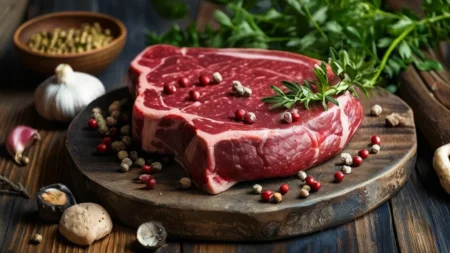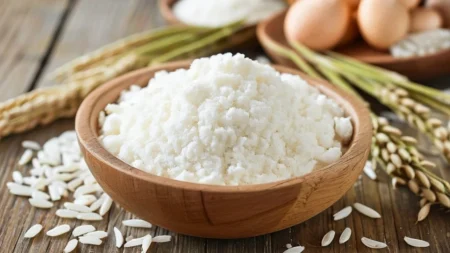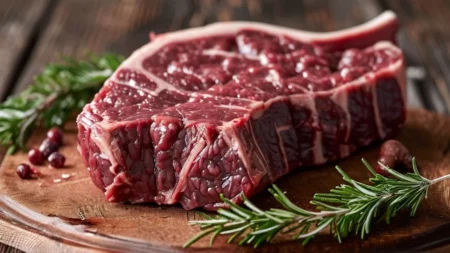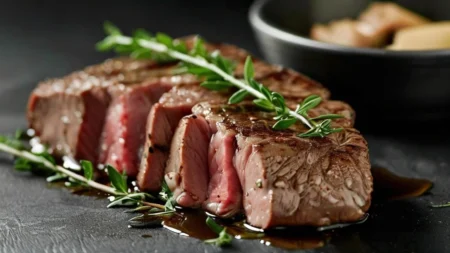Chicken Legs: A Flavorful and Nutrient-Rich Protein Choice
Key Points to Remember:
- Chicken legs contain more fat than chicken breasts, offering richer flavor and juiciness.
- They are packed with essential nutrients, including iron, zinc, and B vitamins.
- Great for those looking to increase calorie intake while still consuming quality protein.

Understanding Chicken Legs
Chicken legs, which include the thigh and drumstick, are a favorite cut of poultry for their juiciness and rich flavor. Unlike the leaner chicken breast, chicken legs contain more fat, which helps retain moisture during cooking and enhances their taste.
Breakdown of Nutritional Value (per 100 grams of cooked, skinless chicken leg)
| Nutrient | Amount |
|---|---|
| Calories | 209 kcal |
| Protein | 26 grams |
| Fat | 10.9 grams |
| Saturated Fat | 3 grams |
| Iron | 1.3 mg (7% DV) |
| Zinc | 2.1 mg (14% DV) |
| Vitamin B6 | 0.4 mg (20% DV) |
| Niacin (B3) | 7.5 mg (47% DV) |
Why Choose Chicken Legs Over Other Cuts?
Chicken legs offer distinct advantages compared to other cuts of chicken. Here’s why they stand out:
1. Higher Fat Content = More Flavor
The higher fat content in chicken legs results in a richer, juicier bite, which is why many chefs prefer them for dishes requiring depth of flavor. The extra fat also means they are less likely to dry out during cooking.
2. Budget-Friendly
Chicken legs are often more affordable than chicken breasts, making them a cost-effective option for families looking to include protein in their diet without overspending.
3. Packed with Essential Minerals
Compared to chicken breasts, chicken legs offer a higher amount of essential minerals like iron and zinc, which are important for immune function, oxygen transport, and overall metabolic health.
Health Benefits of Chicken Legs
1. Supports Muscle Growth
Chicken legs provide around 26 grams of protein per 100 grams, helping to build and repair muscles. For individuals involved in resistance training or looking to build strength, chicken legs are a great addition to their diet.
2. Boosts Energy and Immune System
The B vitamins, especially niacin (B3) and vitamin B6, in chicken legs help convert food into energy and support the immune system. Iron, too, is vital for energy production and preventing anemia.
How to Cook Chicken Legs for Maximum Flavor
There are several popular cooking methods that can enhance the flavor and texture of chicken legs. Here are some suggestions:
1. Roasting
Roasting chicken legs in the oven results in a crispy skin and tender meat. Brush the legs with olive oil and your favorite spices, then roast at 425°F for 35-45 minutes, or until the internal temperature reaches 165°F.
2. Grilling
Grilling is another great option for chicken legs, providing a smoky flavor while keeping the meat juicy. Marinate the legs beforehand for extra taste, and grill for about 25-30 minutes, turning occasionally to ensure even cooking.
3. Slow Cooking
Slow cooking allows the chicken legs to absorb flavors over time, resulting in ultra-tender meat. Cook on low for 6-8 hours with broth, vegetables, and spices for a simple, delicious meal.
Chicken Legs in Comparison to Other Proteins
1. Chicken Legs vs. Chicken Thighs
While both cuts are flavorful, chicken legs have a higher fat content and include the drumstick, offering a different texture. Thighs are slightly leaner but still maintain that rich flavor.
2. Chicken Legs vs. Pork
Chicken legs contain less saturated fat than most pork cuts, making them a heart-healthier choice. However, pork offers a stronger flavor profile, which may appeal to different taste preferences.
3. Chicken Legs vs. Salmon
Salmon provides healthy fats in the form of omega-3s, while chicken legs are higher in protein. For those looking to balance fat and protein intake, chicken legs offer an alternative to fatty fish.
Potential Concerns with Chicken Legs
1. Higher Fat Content
While the fat in chicken legs contributes to their flavor, individuals on low-fat diets might prefer chicken breasts. Additionally, the skin of chicken legs contains most of the fat, so removing it can lower the calorie content.
2. Cooking Time
Chicken legs, especially with the bone in, take longer to cook than chicken breasts. Ensuring they reach the correct internal temperature of 165°F is crucial to avoid undercooking.
Chicken Legs in Popular Cuisines
Chicken legs are used worldwide in many delicious recipes. Here’s how they feature in some well-known cuisines:
1. American Barbecue
Chicken legs are a staple at American barbecues, often coated in a smoky, sweet sauce and grilled to perfection.
2. Indian Cuisine
In Indian cuisine, chicken legs are often marinated in yogurt and spices for dishes like tandoori chicken, where they’re cooked in a traditional clay oven.
3. Mediterranean Dishes
In Mediterranean countries, chicken legs are frequently roasted with herbs like rosemary, thyme, and lemon for a fresh, zesty flavor.
Conclusion
Chicken legs are a flavorful, versatile protein option that offers a wealth of nutritional benefits. Their high protein content, along with essential vitamins and minerals like iron and zinc, makes them an excellent choice for those looking to enhance muscle growth, energy levels, and immune function. While they may be higher in fat compared to chicken breasts, this fat contributes to their rich taste and tenderness. Chicken legs can be enjoyed in a variety of cuisines and cooked using methods that suit your preferences, whether it’s grilling, roasting, or slow cooking.
FAQ
Q: Should I eat chicken legs with the skin on or off?
A: The skin adds extra flavor and fat, but removing it can lower the calorie and fat content, making the dish leaner. It depends on your dietary preferences.
Q: How do I know when chicken legs are fully cooked?
A: Use a meat thermometer to check that the internal temperature reaches 165°F. This ensures the chicken is safe to eat without being overcooked.
Q: Can chicken legs be part of a weight-loss diet?
A: Yes, chicken legs can be included in a weight-loss diet, especially if the skin is removed to reduce fat content. They offer a good balance of protein and essential nutrients.
Q: Are chicken legs better than chicken breasts for building muscle?
A: Both cuts are excellent for muscle building due to their high protein content. Chicken legs, however, provide more fat and calories, which may be beneficial for those needing more energy in their diet.
Q: How long can I store cooked chicken legs in the fridge?
A: Cooked chicken legs can be stored in an airtight container in the refrigerator for up to 3-4 days. For longer storage, freeze them for up to 4 months.










